Static electricity, or a static charge, can either be positive or negative. When certain materials are rubbed together, one become positively charged and the other becomes negatively charged. Tape can be used to see static electricity in action. So stick around and get a charge out of static electricity with tape!
Here's what to do:
- Pull a piece of tape off a roll so that the piece of tape is about 30 cm (1 foot) long and hand the end to your adult partner.
- Pull another piece of tape off a roll that is the same length as the first.
- Slowly bring the two pieces of tape near each other. What do you notice?
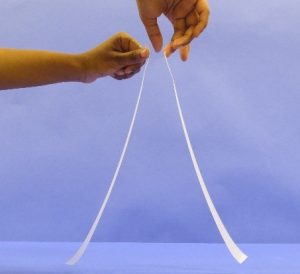
What to expect
The two pieces of tape will repel or move away from each other. It will be very hard to make the hanging ends touch.
4. Ask your adult partner to blow up and tie the balloon and to give it to you.
5. Ask your adult partner to hold one end of one strip of tape and let the rest hang down.
6. Rub the end of the balloon on your hair or shirt.
7. Slowly bring the balloon toward the hanging piece of tape. What did you notice?
Move the balloon back and forth. Would you say that the balloon and the tape are attracted to each other or repelled by each other?
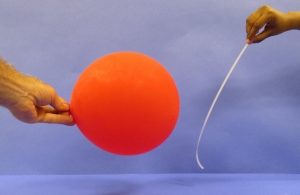
What to expect
When you bring the balloon toward the hanging tape, the tape should be attracted to the balloon and move toward it.
What's happening in there?
Pulling the tape from the roll causes electrons to be stripped off the tape, giving both strips a positive charge. When two objects have the same static charge, they move away or repel one another. Rubbing a balloon on hair causes electrons to move from your hair onto the balloon, giving the balloon a negative charge. When two objects have opposite charges, they attract.
What else could you try?
Try making your own static electricity hover toy!
What you'll need:
- Balloon (round, medium size)
- Light-weight plastic grocery store bag (produce bags work well)
- Scissors
- Tape
Be safe
Be sure to review the safety instructions on page 1 before proceeding.
Here's what to do:
- Ask your adult partner to use scissors to cut a strip from the plastic bag that is about 3 cm. wide and about 50 cm. long.
- Hold one end of the plastic strip firmly with your thumb and index finger. Use your thumb and fingers from your other hand to hold the plastic. Then pull the plastic strip through your thumb and fingers as shown.
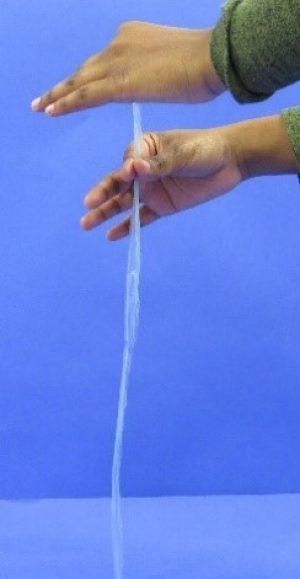
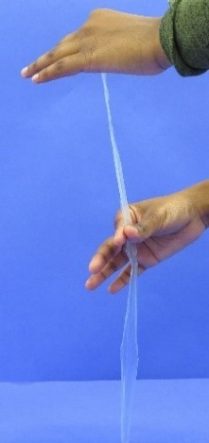
- Now ask your adult partner to hold one end of the plastic strip and let the rest hang down.
- Rub the end of the balloon on your hair or shirt to put a static charge on it.
- Slowly bring the balloon toward the hanging strip of plastic.
What did you notice? - Move the balloon back and forth and see how the plastic moves. Would you say that the balloon and the plastic are attracted to each other or repelled (pushed away) by each other?
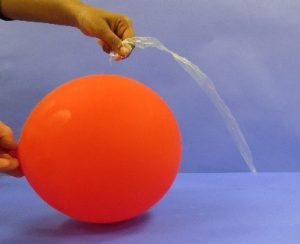
What to expect
As the balloon is brought near the plastic, the plastic should move away from the balloon.
What's happening in there?
The balloon and the plastic must have the same static electric charge. Since objects with the same charge repel each other, the plastic moves away from the balloon.
Make a fun toy!
- Bring the ends of the plastic strip together to make a circle and use a small piece of tape to tape the ends together.
- Rub the balloon on your shirt or hair to put a charge on the balloon.
- Hold the circle of plastic up high and put the balloon underneath it. Let the plastic go and see if you can make it hover using static electricity from the balloon.
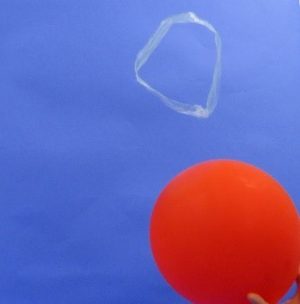
What to expect
If the plastic and balloon are well-charged, you can use the balloon to keep the plastic circle hovering above it. You may even be able to walk around while keeping the plastic circle hovering in the air.
If the plastic doesn’t hover above the balloon, re-charge both of them and try it again.
What's happening in there?
Since the balloon and the plastic have the same static charge, they repel each other and stay apart. The plastic is heavy enough to fall down toward the balloon but the repulsion from the static electricity is strong enough to keep the plastic from falling all the way to the balloon so the plastic hovers.
